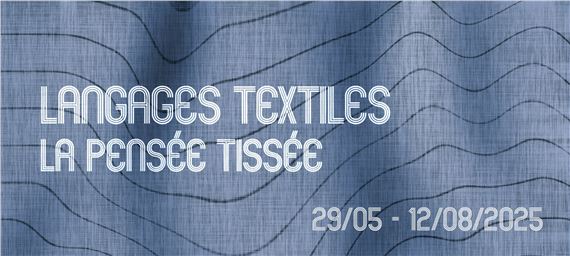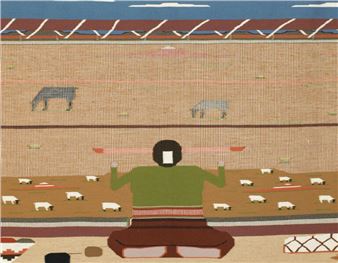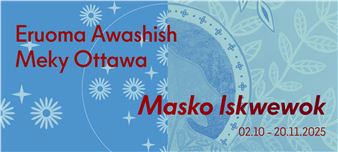Langages textiles, la pensée tissée
La Guilde has played an essential role in preserving and promoting craft practices in Canada since its founding in 1906. Founded on the vision of pioneering women determined to honour and uplift craft traditions, the organization has evolved with the times, supporting artists in their innovative and socially engaged practices. Today, La Guilde continues to celebrate the richness of textile art by showcasing works that weave together tradition and contemporaneity.
Langages textiles, la pensée tissée brings together artists who explore textiles beyond their material properties—approaching them as sites of social engagement, spaces for innovation, and bridges across artistic disciplines. From weaving integrated into paper and sculpture, to textile-based photography capturing narrative threads, to dialogues between fibre and technology, the featured works expand the possibilities of textile expression. They explore how textiles shape our relationship to the land, time, and collective memory.
Some artists draw directly from weaving techniques to structure their visual language. Lizz Aston deconstructs textile patterns into sculptural and optical forms, blending handwork with digital processes. Shane Perley-Dutcher’s creations evoke traditional weaving while paying tribute to Maliseet and Mi’kmaq knowledge, merging ornamental traditions with contemporary aesthetics.
Others examine technology through the lens of textile. In collaboration with Anne Dahl, Elizabeth Johnson uses digital weaving with fibre and metal to reflect on artificial intelligence and creative agency, generating slow, abstract, tactile images. Rythâ Kesselring connects loom rhythms with sound frequencies, exploring textiles as living archives and instruments of memory.
Heather Shillinglaw and Bettina Matzkuhn address the environmental crisis through embroidery, tufting, and collage. While Matzkuhn maps shifting landscapes through textile storytelling, Shillinglaw grounds her practice in Indigenous knowledge tied to the land, medicinal plants, and matrilineal transmission.
Carla Hemlock brings a socially engaged and critical approach, revisiting the Iroquois quilt through a feminist and decolonial lens. Her works, rich in symbolism and narrative, testify to the history and resilience of Indigenous peoples.
A pioneer in digital Jacquard weaving, Louise Lemieux Bérubé creates immersive textile images that blur the boundaries between photography and materiality, drawing viewers into a sensitive, tactile landscape.

Recommended for you
La Guilde has played an essential role in preserving and promoting craft practices in Canada since its founding in 1906. Founded on the vision of pioneering women determined to honour and uplift craft traditions, the organization has evolved with the times, supporting artists in their innovative and socially engaged practices. Today, La Guilde continues to celebrate the richness of textile art by showcasing works that weave together tradition and contemporaneity.
Langages textiles, la pensée tissée brings together artists who explore textiles beyond their material properties—approaching them as sites of social engagement, spaces for innovation, and bridges across artistic disciplines. From weaving integrated into paper and sculpture, to textile-based photography capturing narrative threads, to dialogues between fibre and technology, the featured works expand the possibilities of textile expression. They explore how textiles shape our relationship to the land, time, and collective memory.
Some artists draw directly from weaving techniques to structure their visual language. Lizz Aston deconstructs textile patterns into sculptural and optical forms, blending handwork with digital processes. Shane Perley-Dutcher’s creations evoke traditional weaving while paying tribute to Maliseet and Mi’kmaq knowledge, merging ornamental traditions with contemporary aesthetics.
Others examine technology through the lens of textile. In collaboration with Anne Dahl, Elizabeth Johnson uses digital weaving with fibre and metal to reflect on artificial intelligence and creative agency, generating slow, abstract, tactile images. Rythâ Kesselring connects loom rhythms with sound frequencies, exploring textiles as living archives and instruments of memory.
Heather Shillinglaw and Bettina Matzkuhn address the environmental crisis through embroidery, tufting, and collage. While Matzkuhn maps shifting landscapes through textile storytelling, Shillinglaw grounds her practice in Indigenous knowledge tied to the land, medicinal plants, and matrilineal transmission.
Carla Hemlock brings a socially engaged and critical approach, revisiting the Iroquois quilt through a feminist and decolonial lens. Her works, rich in symbolism and narrative, testify to the history and resilience of Indigenous peoples.
A pioneer in digital Jacquard weaving, Louise Lemieux Bérubé creates immersive textile images that blur the boundaries between photography and materiality, drawing viewers into a sensitive, tactile landscape.

 ARTISTS
ARTISTS
















